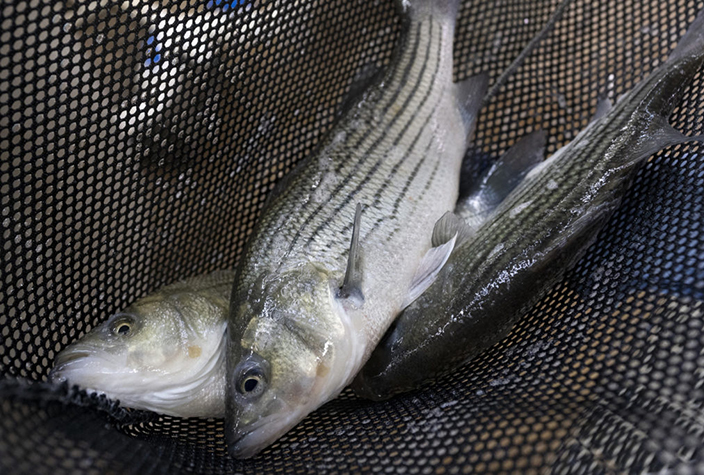Feeding fish: Scientists improve nutritional strategies for farmed bass

The United States is the top producer of hybrid striped bass and a Texas A&M AgriLife team is working to improve the fishes’ health, growth and productivity by developing effective nutritional strategies to substitute fishmeal and other protein feedstuffs in the farmed bass diets.
Aquaculture is the fastest-growing agricultural enterprise in the world. The field is expected to continue growing to provide seafood for the world’s expanding population.
Some fish species produced in aquaculture, such as the omnivorous catfish and carps, consume diets without any fishmeal. However, more carnivorous species such as hybrid striped bass have traditionally been fed diets with a considerable amount of fishmeal, which is a very nutritious but costly marine feedstuff.
The U.S. Department of Agriculture National Institute of Food and Agriculture has awarded two grants totaling $1.15 million to the team’s studies of hybrid striped bass. The work will be led by Guoyao Wu, College of Agriculture and Life Sciences University Distinguished Professor and Texas A&M AgriLife Research Faculty Fellow in the Department of Animal Science at Texas A&M.
Teaming up with Wu on one study, “Biosynthesis and nutritional roles of glycine in hybrid striped bass,” is Delbert Gatlin, Regents Professor in the Department of Ecology and Conservation Biology, Bryan-College Station. On the second study, titled “Impact of dietary glutamate on the development of gut mucosal immunity in hybrid striped bass,” Wu will collaborate with Mike Criscitiello, professor of veterinary pathobiology and associate dean for research and graduate studies in the College of Veterinary Medicine and Biomedical Sciences.
Generally speaking, fishmeal and fish oil production are environmentally and ecologically sustainable, Gatlin said. Their production has not varied much over the past few decades, and both have rather good life cycle assessments compared to other feed resources.
“However, their supplies are limited, so as world aquaculture is projected to continue growing, the costs of these marine ingredients are expected to increase,” he said. “So, there will likely be greater need to substitute larger portions of fishmeal and fish oil in the diets of various fish species, especially the ones with more carnivorous natural feeding habits. Thus, our project should allow greater flexibility in formulating diets to meet the nutritional requirements of hybrid striped bass without relying on fishmeal or other feedstuffs.”
Wu said fishmeal has traditionally been used as the major protein feedstuff in hybrid striped bass diets, but because of the increasing demand and escalating costs, there is a growing interest in using plant proteins such as soybean meal to replace fishmeal in aquafoods. But success has been variable, he said.
“We found that glycine, the most abundant amino acid in the body of fish and fishmeal, is relatively low in plant proteins,” Wu said. “Based on results of our preliminary study, we believe that dietary glycine plays an important role in hybrid striped bass growth by maximizing protein synthesis, anti-oxidative capacity and creatine production in their tissues.”
Glutamate, the second most abundant amino acid in the body of fish and fishmeal, acts with glycine to promote metabolic processes. Collectively, the scientists believe both glutamate and glycine should be considered “functional amino acids” in animal nutrition.
Glutamate and glycine “are the cheapest amino acids, and yet hold great promise as cost-effective feed additives,” Wu said. “In addition, fish are excellent animal models to translate the basic research findings into the efficient production of high-quality animal protein for human consumption.”

